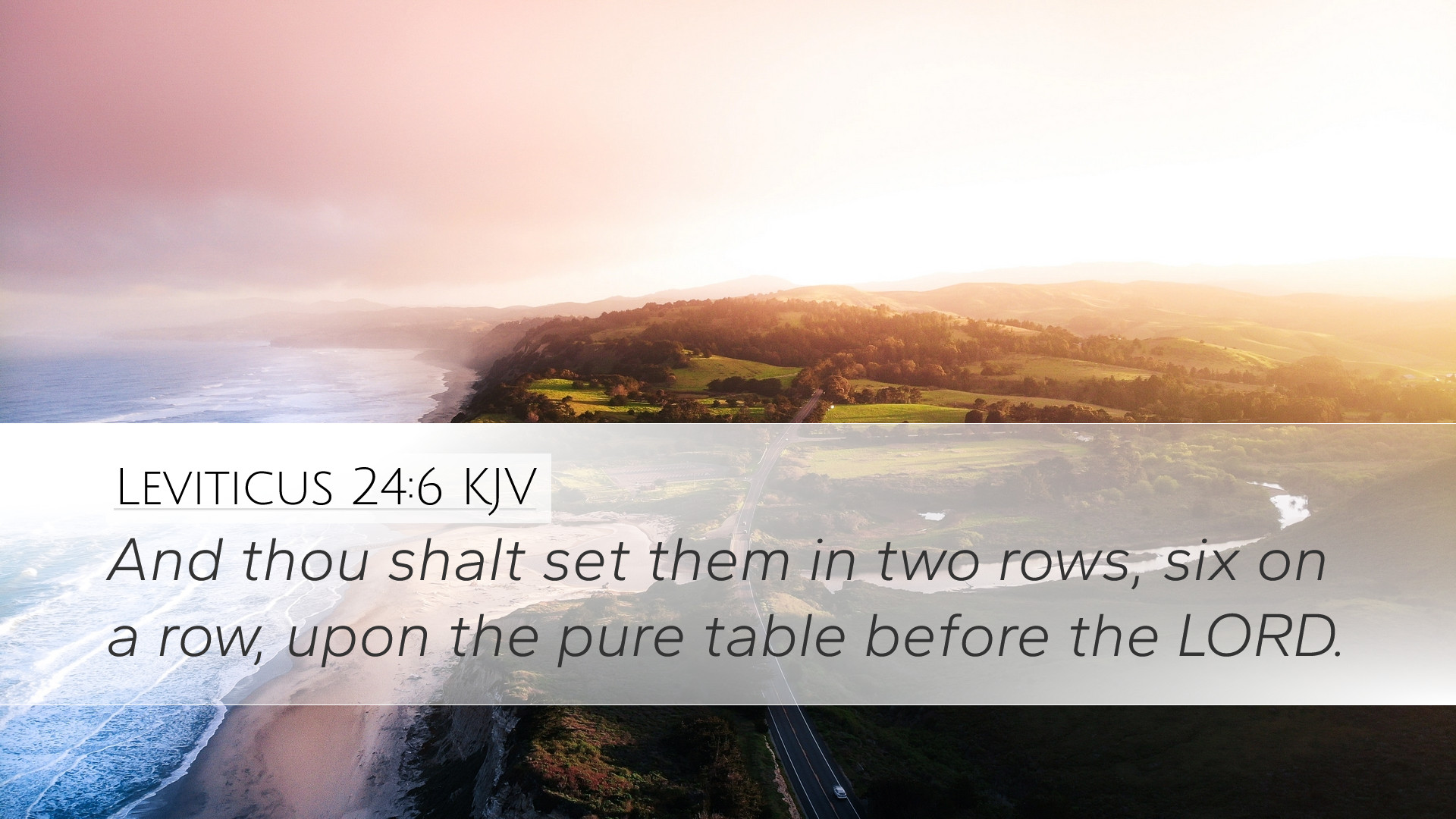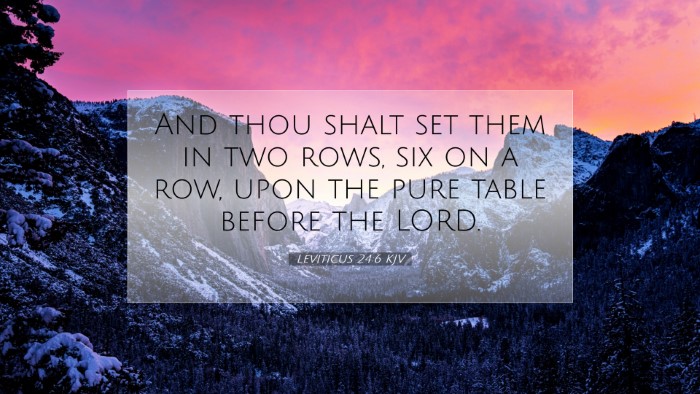Bible Commentary on Leviticus 24:6
Leviticus 24:6 states: "And you shall set them in two rows, six in a row, on the pure gold table before the Lord." This verse comes within a significant instructional context regarding the showbread, which is a vital aspect of Israelite worship and symbolizes the divine provision and presence of God among His people. Below is a compilation of insights from renowned public domain commentaries.
Contextual Overview
The Book of Leviticus primarily serves as a manual for worship and holiness, expounding upon the laws and rituals that the Israelites must follow to maintain their covenant relationship with God. The showbread, also known as the "bread of the Presence," constituted a part of the sacrificial system and was regularly presented before God in the tabernacle.
Matthew Henry's Commentary
Matthew Henry, in his exegesis, emphasizes the significance of the showbread as a representation of God's continual provision for His people. He notes:
- It is pertinent that the bread is placed before the Lord; this suggests a divine acknowledgment of sustenance and fellowship.
- Henry underscores the arrangement of the bread in rows, reflecting order, beauty, and the divine principle of organization in worship.
Moreover, Henry points out that the showbread is a symbol of the Messiah, who is the true bread of life. This typological interpretation aligns with Jesus' declarations in the New Testament, drawing a parallel between the physical sustenance provided to the Israelites and the spiritual nourishment available in Christ.
Albert Barnes' Notes
Albert Barnes offers a detailed analysis of the practical implications of the verse:
- He highlights the materials involved—the pure gold of the table representing divine holiness and the necessity of offering only the best to God.
- Barnes emphasizes the communal aspect of worship, where the showbread serves as a reminder of God's ongoing relationship with Israel and His everlasting covenant.
Barnes also discusses the frequency with which the bread was changed, marking the continuity of worship and the reminder that the Lord is always present among His people. The arrangement in two rows symbolizes order and accessibility, inviting the priests to serve in a structured manner.
Adam Clarke's Commentary
Adam Clarke dives deeper into the symbolic elements of the showbread. He notes:
- The number twelve (six in each row) is suggestive of the twelve tribes of Israel, reinforcing the idea that God remembers and provides for each tribe.
- Clarke makes the connection between the bread and the sustenance of the spirit, asserting that God's provision extends beyond physical bread to the Bread of Life that nourishes the soul.
Additionally, Clarke remarks on the specific command regarding the bread's arrangement, symbolizing not only coherence in worship but also a reminder to the Israelites of the importance of discipline and reverence in their relationship with God. The pure gold table signifies that the worship of God should be carried out with the utmost purity of heart and dedication.
Theological Implications
This passage carries profound theological implications for pastors, students, theologians, and scholars:
- Symbol of Provision: The showbread serves as a timeless symbol of God's provision for His people, emphasizing the necessity of recognizing our daily dependence on Him.
- Order and Reverence in Worship: The meticulous arrangement of the bread before the Lord illustrates the significance of structure and reverence in the worship experience, which can apply to modern church practices.
Furthermore, this verse opens avenues for understanding the sacrificial system's typology in relation to Christ, whose body is the ultimate bread of life provided for the sustenance of humanity's spiritual hunger.
Practical Applications
In light of the scholarly insights derived from Henry, Barnes, and Clarke, the following applications emerge:
- Incorporate a deeper understanding of the showbread into pastoral teaching, illustrating its significance as a tool for communion with God.
- Encourage congregations to appreciate the order, beauty, and intentionality of worship, recognizing that these elements direct the heart toward God.
- Utilize the metaphor of bread as a means of discussing spiritual nourishment, prompting discussions on how believers can seek sustenance from Christ amidst life's challenges.
Conclusion
Leviticus 24:6 encapsulates core principles of worship, provision, and community in the covenant relationship between God and Israel. As we understand the implications of setting the showbread before the Lord, we are reminded of the importance of approaching God with reverence, recognizing His sustenance in both physical and spiritual matters. This commentary synthesizes classical interpretations, offering a rich resource for continued exploration and application within the church and theological studies.


